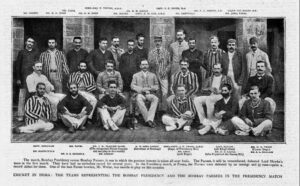 In India, though cricket was first played back in the 1720s by English Mariners at Cambay (Khambat), it was only later that a more organized version was developed in Calcutta and Bombay, played between English residents and visiting soldiers /sailors, heralding the arrival of the sport in India.
In India, though cricket was first played back in the 1720s by English Mariners at Cambay (Khambat), it was only later that a more organized version was developed in Calcutta and Bombay, played between English residents and visiting soldiers /sailors, heralding the arrival of the sport in India.
Historically, Parsis of India were the first to adapt to cricket, already being acquainted with the ‘bat and ball’ concept of playing ‘chugan gui’ in Iran, which bore some resemblance to cricket. ‘Chugan gui’ or ‘Chovgan’ (pronounced as ‘caukan’ in Iran) was originally a royal sport that originated sometime in 1st century AD, played mainly on trained horses in central Asian countries like Iran, Azerbaijan, Uzbekistan and Tajikistan. Later, in the 19th century, the English adopted the sport and called it horse-Polo!
Watching the military officers of the Marine Battalion play cricket, that so much resembled ‘chovgan’, ignited the latent craving of the Parsis for the sport. In the 1830s, an English schoolteacher – Boswell – first taught Parsi students cricket, in a school he ran in Mumbai’s Fort area. They took to the game seriously. If Bombay became the cricketing meadow of India, Parsis were the horticulturists who first sowed the seeds of desire for the sport, even fashioning their own bats and balls! Such was the zeal to play cricket!
Soon, the sport gained popularity, as almost thirty Parsi cricket clubs were established in Bombay alone, mostly named after British Viceroys, Greek mythological figures or Roman Gods. The first Parsi cricket club – The Oriental Cricket Club , established in 1848, existed for only two years but ignited passion in the community (Ref. Parsi Cricket by Dr. M E Pavri). In 1850, The Zoroastrian Cricket Club was founded, comprising Parsi stalwarts – Doli Faresta, M R Dalal, N S Mistri, B P Noria, H C Jassawalla, S R Bhapoo, B N Parekh, M C Mistri, F A Diventry, N F Avasia and B R Limboowalla.
Initially, the bowling was mainly under-arm as round-arm bowling started only in 1867. Parsi greats like ‘Navloo’ Mama, ‘Jabooli’ Poonegar and N N Gheewalla were pioneers of fast, round-arm bowling action in India.
From 1868, various Parsi clubs began playing inter-club matches, sponsored by the great patron – Seth Shapoorji Sorabjee Bengali, a writer and social reformer. These matches were played with serious competitiveness that sometimes even stimulated deceptive means of winning. Once a Parsi cricketer even impishly disguised himself to bat a second time in the same innings, during a game between two Parsi clubs!
Parsis in Bombay initially played at the Oval maidan till a random cricket ball struck the wife of a European police constable, strolling in the field. This incident led to the banning of Parsis from playing at the Oval. Sir Joseph Arnauld, Chief Justice of Bombay and Editor of Bombay Gazette, however stepped in, and got permission for the Parsi cricketers to play at the Esplanade Maidan, instead.
In 1876, Seth Ardeshir B. Patel founded The Parsi Cricket Club, contributing significantly to the game. In 1877, he arranged the first 3-match tournament against the formidable all-white, Bombay Gymkhana, comprising some outstanding English cricketers of the time. Although the Parsi Cricket Club lost two matches with a drawn third, the tournament provided an impetus to the underdogs to improve their game. Subsequently, the Parsi Cricket Club played seven matches against the English XI and had a praiseworthy record of two wins, two losses and three drawn matches, mainly thanks to an outstanding batting performance of ‘Murgi’ Khan Saheb Bhicaji!
The other active Parsi club of the time was The Baronet Cricket Club, an off-shoot of the Juvenile Cricket Club or the Bombay Cricket Club, that was skillfully managed by Edulji Mody for almost two decades. From the Baronet Cricket Club sprang the John Bright Cricket Club in 1884, which was renowned for its cricketing pool of talent and abilities. It was for this club that the great Dr. M E Pavri (author’s great grand maternal uncle) first played and evolved to become one of the greats of the cricketing history.
In 1885, The Parsi Gymkhana was established, thanks to the untiring efforts of Seth N N Wadia, Seth Jamshedji Tata, Sir Dorabji Tata, Seth K N Seervai, Seth J M Patel and Seth D R Chichgar, who managed to acquire a plot of reclaimed land located at Kennedy Sea Face (now Marine Drive). Soon after, most Parsi clubs that had sprouted in the 19th century, became defunct, with the exception of the Young Zoroastrians Club, originally founded by Hiraji Costa – an outstanding wicketkeeper of his time.
Though in 1886, ‘India’ made an unofficial tour of England, with an all-Parsi team to play against the mighty Marylebone Cricket Club (MCC), led by William Gilbert ‘WG’ Grace, it was during their second tour of England in 1888, that the all-Parsi team demonstrated a brilliant, all-round performance by winning at Hastings and Eastbourne, and losing to Surrey, by a mere nine runs.
